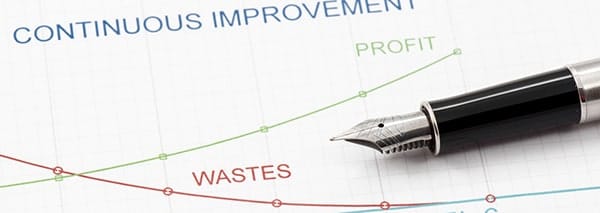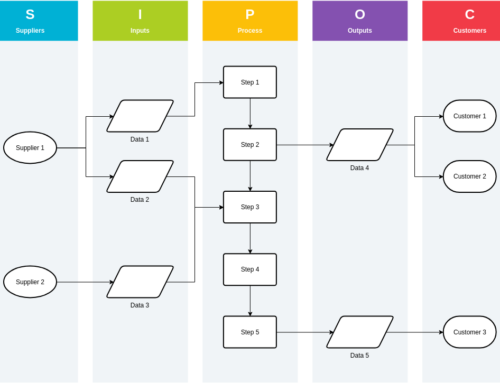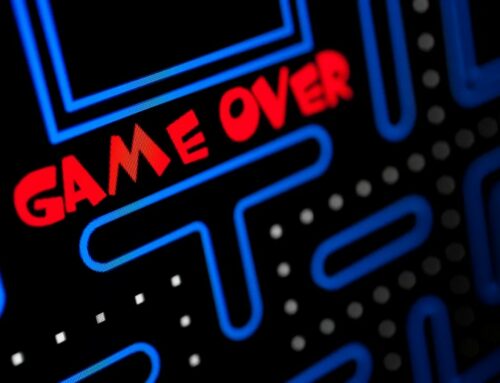The 8 Wastes of Lean Manufacturing
Lean Manufacturing defines “Waste” anything that does not add value. In order for something to add value is should modify the form, fit or function of a product, part, or service.
What are the 8 Wastes of Lean Manufacturing?
To remember the 8 Wastes of Lean, you can use the acronym, ” DOWNTIME”
- Defects
- Over Production
- Waiting
- Non-Utilized Talent
- Transportation
- Inventory
- Motion
- Excess Processing

How to Tag Projects in KPI Fire with 8 Wastes in your Continuous Improvement Projects.
Defects
Defects impact time, money, resources and customer satisfaction. They’re products or services that are out of specification which require resources to correct. This typically results in either reworking or scrapping the product. Both results are wasteful as they add additional costs to the operations without delivering any value to the customer.
Defects can manifest themselves in different ways, but the reason they occur often stems from the fact that there was a failure to implement steps to catch and correct human error.
Specific defect causes include:
- Poor quality control at the production level.
- Poor machine repair.
- Lack of proper documentation.
- Lack of process standards.
- Not understanding your customers’ needs.
- Inaccurate inventory levels.
What are countermeasures for defects?
- Design processes so they are less likely to produce defects.
- Design processes to detect abnormalities so they can be immediately corrected.
- Look for the single most frequent defect and determine why it occurs.
- Create work instructions that provide a consistent method of manufacturing the part.
How you can use the Pareto principle and Pareto Charts to help eliminate defects.
Over Production
OVERPRODUCTION
Overproduction occurs when manufacturing a product or an element of the product before it’s being asked for or required. Overproduction can create several negative effects.
While it might be tempting to produce as many products as possible, this tactic, the “Just in Case” way, causes a host of problems. This strategy can prevent smooth workflow, drive up storage costs, and hide defects in the inventory among others.
In an office environment, overproduction could include making extra copies, creating reports no one reads, providing more information than needed, and providing a service before the customer is ready.
Rather than a “Just in Case” strategy, Lean methodologies believe businesses are better off subscribing to the “Just in Time” concept of production. This production philosophy focuses on customer demand instead of producing as much product as possible, and allows your company to operate more efficiently.
Common causes of overproduction include:
- Unreliable process.
- Unstable production schedules.
- Inaccurate forecast and demand information.
- Customer needs are not clear.
- Poor automation.
- Long or delayed set-up times.
What are countermeasures for overproduction?
- Pace production so the rate of manufacturing matches the rate of customer demand.
- Use a pull system to control how much is manufactured.
- Reduce setup times so that smaller batches can be economically manufactured.
Waiting
In many ways, waiting is the opposite of overproduction. Waiting is perhaps the easiest of manufacturing wastes to overlook. The waste of waiting includes people waiting on material or equipment and idle equipment. Waiting time is often caused by unevenness in the production stations and can result in excess inventory and overproduction.
In an office setting, a good example of waiting is unnecessary or excessive meetings, long email chains, long queue of files waiting to be approved, and more.
Common causes of waiting include:
- Unplanned downtime or Idle equipment.
- Long or delayed set-up times.
- Poor process communication.
- Lack of process control.
- Producing to a forecast.
- Idle equipment.
What are countermeasures for waiting?
- Design processes so that the flow is continuous and there are minimal (or no) buffers between steps in production.
- Use standardized work instructions to ensure that a consistent method and consistent times are used for each step of production.
Non-Utilized Talent
The elimination of this type of waste can improve all others. This type of manufacturing waste occurs when management in a manufacturing environment fails to ensure that all their potential employee talent is being utilized. When workers are given the opportunity to thrive in the workplace, they work their hardest and best.
By engaging employees and incorporating their ideas, providing training and growth opportunities and involving them in the creation of process improvements that reflect the reality they experience and the skills they possess, overall operational effectiveness is improved.
In the office, non-utilized talent could include insufficient training, poor incentives, not asking for employee feedback, and placing employees in positions below their skills and qualifications.
In manufacturing, this waste can be seen when employees are poorly trained, employees not knowing how to effectively operate equipment, when employees are given the wrong tool for the job, and when employees are not challenged to come up with ideas to improve the work.
For companies to operate efficiently and productively, they must fully invest in their workers, and complete training is a great place to start.
Examples of non-utilized talent:
- Poor communication.
- Failure to involve people in workplace design and development.
- Lack of or inappropriate policies.
- Incomplete measures.
- Poor management.
- Lack of team training.
“However beautiful the strategy, you should occasionally look at the results.” —Winston Churchill
Transportation
Waste in transportation includes movement of people, tools, inventory, equipment, or products further than necessary. Excessive movement of materials can lead to product damage and defects. Additionally, excessive movement of people and equipment can lead to unnecessary work, greater wear and tear, safety issues, and exhaustion.
In the office, workers who collaborate with each other often should be close together. In the factory, materials necessary for production should be easily accessible at the production location and double or triple handling of materials should be avoided.
Common types of transportation waste:
- Poor layouts – large distance between operations.
- Long material handling systems.
- Large batch sizes.
- Multiple storage facilities.
- Poorly designed production systems.
What are countermeasures for transport?
- Take a Gemba walk, paying especially close attention to the steps involved in production.
- Redesign processes, focusing on ways to minimize movement and streamline manufacturing.
- Design a linear, sequential flow from raw materials to finished goods.
Inventory
Often times it is difficult to think about excess inventory as waste. In accounting, inventory is seen as an asset and oftentimes suppliers give discounts for bulk purchases. But having more inventory than necessary to sustain a steady flow of work can lead to problems.
Excess inventory prevents detecting production-related problems since defects have time to accumulate before it is discovered. As a result, more work will be needed to correct the defects.
In-office inventory waste could be files waiting to be worked on, customers waiting for service, unused records in a database, or obsolete files. Manufacturing inventory waste could include broken machines sitting around, more finished products than demanded, extra materials taking up work space, and finished products that cannot be sold.
What are countermeasures for inventory?
- Bring raw materials in only as they are needed and only in the quantity needed.
- Reduce or eliminate buffers between steps in production.
- Refer to Overproduction countermeasures.
“Lean is about constant ticking, not occasional kicking.” – Alex Miller
Motion
Motion costs money. The waste in motion includes any unnecessary movement of people, equipment, or machinery. This includes walking, lifting, reaching, bending, stretching, and moving. Tasks that require excessive motion should be redesigned to enhance the work of personnel and increase the health and safety levels.
In the office, wasted motion can include walking, reaching to get materials, searching for files, sifting through inventory to find what is needed, excess mouse clicks, and double entry of data.
Manufacturing motion waste can include repetitive movements that do not add value to the customer, reaching for materials, walking to get a tool or materials, and readjusting a component after it has been installed.
Common motion waste examples include:
- Poor workstation layout.
- Poor production planning.
- Poor process design.
- Shared equipment and machines.
- Siloed operations.
- Lack of production standards.
What are countermeasures for motion?
- Ensure that work areas are logically organized.
- Consider alternate arrangements of equipment that reduce motion.
“Lean thinking defines value as providing benefit to the customer, anything else is waste.” -Eric Ries
Extra Processing
Extra processing refers to the concept of adding more features or producing a product or service of higher quality than required by the customer.
One simple way to counter extra processing is to understand the work requirements from the standpoint of the customer. Always have a customer in mind before starting work, produce to the level of quality and expectation that the customer desires, and make only the quantities needed.
Examples of excess processing include:
- Poor communication.
- Not understanding your customers’ needs.
- Human error.
- Slow approval process or excessive reporting.
What are countermeasures for extra processing?
- Better understanding of your customer’s product expectations.
- Have customer expectations in mind before designing production processes.
- Produce to the quality level customer desires/needs.
Identifying and Eliminating the 8 Wastes of Lean
The first step to reducing waste is recognizing that they exist and having an effective process for identifying them. In order to identify wastes, start with the end customer in mind. Work backwards from the end customer to the start of the production processes.
Document instances of the 8 wastes in the processes and develop a plan for eliminating or reducing them. Continue challenging your team to find more wastes and continuously improve your processes. Engage with the frontline workers and elicit their ideas for improvement. As your team begins reducing efficiencies they will gain more confidence in their problem-solving capabilities and over time reducing waste becomes a part of their daily routine.
What is Waste?
Everyone has two jobs to do:
1: Do your work.
2: Improve your work.
To improve your work you must eliminate waste. To figure out what waste is in your company ask the question whether the work or activity you’re doing is valuable to the consumer. In other words, would your customers be willing to pay for it? To know what your customers find valuable, and are willing to pay you for, you must first understand your customers’ needs. There are some simple ways to understand customer needs. One way is to take on the mindset of your customer. Start thinking like your customer by doing external research to understand trends in the industry. Learn more about the common challenges that your customers face, and better assess how your product or services can provide solutions.



